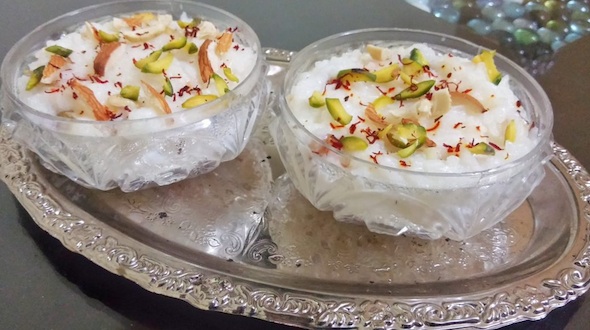Mama’s Punjabi Recipes: Chawal di Kheer (Rice Pudding)
Saved under Community, Current Stories, Recipe Corner
Tags: Baytown, Chawal di kheer, Clear Lake, Cypress, Desi news, Greater Houston, Gulab Jamun, Houston, Houston Desi news, India, Indian American community, Indian News, Indians in America, Indo-American News, Katy, mama recipe, Mama’s Punjabi Recipes, NRI, pearland, Rice pudding, south asia, South India, Sugar Land, Texas, USA
In cold weather, people like to huddle with sweets, nuts and wonderful aromas like this recipe which is the best way to usher in a New Year. Below is a reprint of Mama’s Chawal di Kheer recipe, which is a tasty sweet popular in many Indian restaurants and is delightful in any season. It is reprinted with some additional information and directions.
Kheer has become a staple dessert in so many Indian restaurants South Asian restaurants, just like the equally popular ras malai (cottage cheese in creamed milk) that you can almost predict what’s on the menu. Part of the reason is that kheer is a simple and inexpensive dessert to make. But this does not mean that all restaurants make it equally well. Far too many make kheer with boiled rice soaked in a thin milky syrup, which does not do justice to this dessert.
To make tasty kheer that people will rave over, it has to be made properly: in a thick milk base (but not dry), with nuts and sprinkled with some cardamom powder for added flavor. Some people even make it in a slow cooker, though I prefer making it in a large pot where I can keep an eye on how it is coming along.
The term “kheer” comes from the Sanskrit word ksheeram (which means milk), but the dish is also known as payasam in South India or payesh in Bengal. The recipe for the popular English rice pudding is believed to have originated from kheer. Other types of kheer are made with broken wheat, sabudana (tapioca) or seviyan (vermicelli).
Kheer is found all over India, though the true North Indian version is made with ghee, rice, sugar, cardamom, raisins, kesar (saffron) and dried fruit in thickened milk. It is prepared for festivals, in temples and many special Hindu occasions though it is equally popular – especially the one made with vermicelli – among Muslims for Islamic celebrations.
Kheer has made a comeback as a chic dessert at wedding where the thickened variety is presented in small earthen dishes, garnished with strands of saffron, chopped almonds and pistachios and with a small piece of sona ka varak (gold film).
Ingredients:
• 4 cup doodh (milk) – whole is best, but low-fat will do too
• 1 cup chawal (rice)
• ¼ cup chinni (sugar)
• 2 tbsp condensed milk (if used, you can reduce the sugar)
• ¼ tsp ilachi powder (cardamom powder)
• Dry fruits to your taste: kishmish (raisans); badam (almonds – peeled and slivered); piste (pistachios – halved or pieces)
Directions:
1. Pour the milk in a large, open-faced pot (to avoid boiling over) and bring to a boil over medium heat.
2. Meanwhile, wash the rice in cold water and let it soak in the water.
3. Once the milk has come to boil, pour the rice through a strainer, then pour the rice into the milk. Stir occasionally to make sure the milk does not stick to the pot.
4. In a little while the milk will get thicker and the rice will mix well. Now, add the sugar (condensed milk if you like too) and throw in the dry fruits. The peeled, slivered almonds taste best.
5. Thicker kheer tastes best. It can be served hot, but most people prefer to eat it cold, so refrigerate for an hour or two before serving.
MAMA’S TIP OF THE WEEK:
MAKE SURE TO WASH DRIED METHI BEFORE USING IT
Some ingredients, like methi (fenugreek) are used in sparing quantities, as they bring added aroma and taste to any dish they are mixed in with. Also – again like methi – they are often expensive and difficult to buy in large quantities and then sort and clean before cooking. It has indeed a long time since I have had a dish of fresh methi and aaloo (potatoes); the last time may have been in India a few years ago.
Thankfully, methi can be picked and dried to use for another day, and has been available in small packets for years in many stores. To make tasty methi dishes, you only need a small quantity. However, when you start to use the packet methi, be sure to first clean it by washing it in cold water. Let the methi soak in a pot of water, then skim the floating pieces off the top. You’ll be surprised to see how much dirt settles to the bottom!

Shakuntla Malhotra is a skilled cook of Punjabi dishes made in the old-fashioned style that she learnt as a young woman in her ancestral home in Lyallpur, India (since renamed Faisalabad) before it became part of Pakistan after the Partition in 1947. People have often admired her cooking for its simplicity and taste that comes with each mouthful. Even in her late-eighties, she continues to cook daily and agreed to share her delectable Punjabi vegetarian recipes for future generations.

